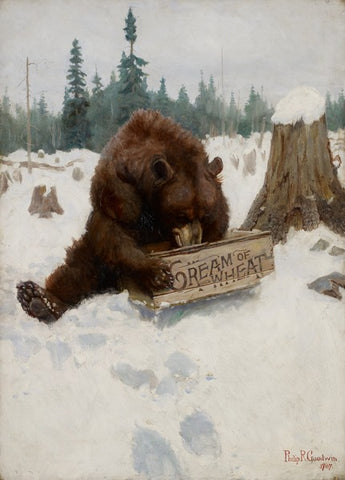Image of the Week 6/3/16 - Wild Bill Hickok at Cards and A Bear Chance June 03 2016

1-1 Wild Bill Hickok at Cards – I’m Calling the Hand That’s in Your Hat
Wyeth, N. C. (1882–1945)
1916
For The Great West that Was by William Cody. Heart’s Magazine. Vol. 30. No. 4. 1916. 245.
Online Sources: http://www.gutenberg.org/files/12740/12740-h/12740-h.htm#04.
In An Autobiography of Buffalo Bill (Colonel F. Cody. New York. Farrar and Rinehart. 1920. 56. http://babel.hathitrust.org/cgi/pt?id=uc1.32106000652039;view=1up;seq=71
1-2 A Bear Chance
Goodwin, Philip R. (1882–1935)
1907
Minneapolis Institute of Arts; Gift of the National Biscuit Company.
Online Source: https://www.1000museums.com/art_works/philip-r-goodwin-a-bear-chance
This week’s “image of the week” is a two-image set. Both pictures were painted by former students of Howard Pyle, the so-called “Father of American Illustration.” Philip R. Goodwin (1882–1935) and N. C. Wyeth (1882–1945) were classmates in the Howard Pyle Scool of Illustration in Wilmington, Delaware. They both arrived in Wilmington in 1902 and “graduated” in 1904. Goodwin then returned to New York City where he opened a studio, possibility around 10th and Broadway, which was near several major publishing houses. Wyeth remained in Wilmington until 1908 when he moved his growing family and studio to Chadds Ford, Pennsylvania.
Goodwin’s ad, which he created for the Cream of Wheat Co. in 1907 appeared first. While studying with Pyle in 1902, Goodwin had received a commission from the Macmillan Company of New York to illustrate Jack London’s Call of the Wild. The book and the illustrations were both successes. I suppose this is how Cream of Wheat discovered Goodwin. He went to a very success career creating image of outdoor and hunting scenes. I put him in this post because he was what I call an “artist adman.” He applied the techniques he learned from Howard Pyle to create an appealing ad. When viewers saw it, they got the message.
Wyeth also created ads for Cream of Wheat. I put him in this post, however, because he was the quintessential storyteller. Pyle encouraged his students to insert themselves in the stories they illustrated. They could create more engrossing scenes, he said, if they became personally involved in them. None of Pyle’s student, nor anyone else, was better at involving himself in his stories than Wyeth. His itchy finger is on that trigger. He’s staring anxiously down that long dangerous barrel. He had the capacity to bring his audiences into his pictures—we’re right there with him. It this case, like so many others, we’re waiting on the edge of our seats to find out what happens. His career was even more spectacular than Goodwin’s.
These are just two artists and two pictures from the Golden Age of Illustration. I’ll be talking about many more in the weeks ahead. Bear in mind as you look at the pictures that art had come from one place and was on its way somewhere else.
Jim Thompson
Illustration Art Enthusiast
jct@commonwealthbooks.org





